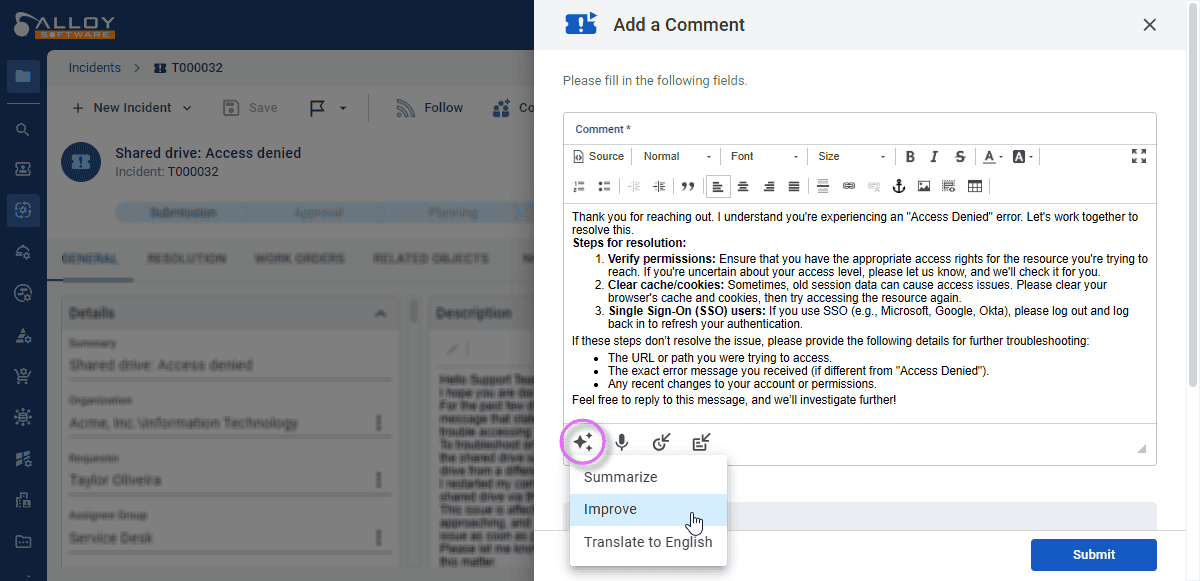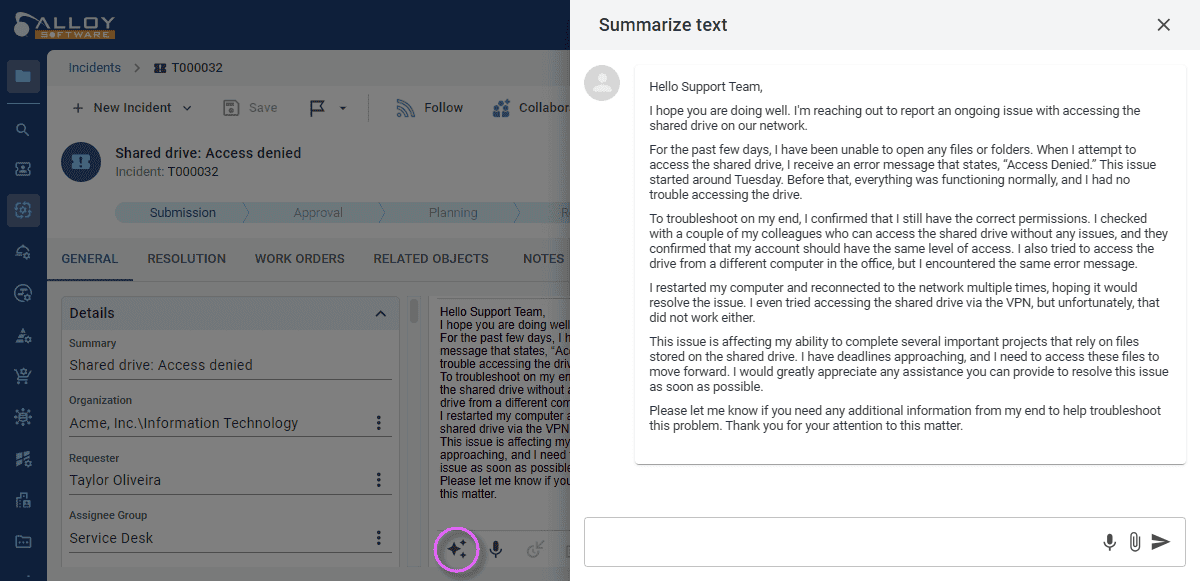AI in ITSM: 3 Artificial Intelligence Applications Vendors Already Use
How has AI shaped ITSM? We analysed 8 leading ITSM vendors to find out how they implemented AI in their solutions.
How has AI shaped ITSM? We analysed 8 leading ITSM vendors to find out how they implemented AI in their solutions.
In December 2022, OpenAI released its first public ChatGPT model, and the rest is history.
While the tool is obviously unprecedented in its use case scenarios, many have expressed concerns about its adoption due to the shifts it may cause in the labor market. Practitioners across industries have gone from love to hate, back to love, and then again to hate toward generative AI.
The current sentiment about the adoption of machine learning anf artificial intelligence seems to align with what Karim Lakhani from Harvard Business Review said: “AI won’t steal your job – people using AI will.”
What about AI in ITSM? With the transformation which artificial intelligence brought into customers support, there is evidently potential for automation in ITSM, too.
For this article, I have researched AI applications used by the biggest ITSM vendors and highlighted three of the most remarkable AI use cases in ITSM.
Imagine an IT support agent drafting a response to an end user who reported a system login issue:
“Hi, we noticed the login problem on your end. Please check if your network is stable and try again. Let us know if it still doesn’t work.”
The message is clear but rushed, with a tone that feels a bit too casual. Moreover, the agent knows she might make grammatical mistakes and isn’t confident she can send over the message as it is.
She then clicks the “Improve” button in the reply field. In moments, the AI writing assistant suggests a better version of the message, enhancing the tone to sound more professional:
“Thank you for reaching out. We’ve identified a potential login issue on your end. Could you please verify your network connection and try logging in again? If the issue persists, feel free to contact us for further assistance.”
With just one click, the agent delivers a polished, professional response—without sacrificing time or effort.
AI writing tools streamline communication and empower IT support agents to respond swiftly and accurately, ensuring end-users receive clear and consistent communication—even in high-pressure situations.
In our Fall 2024 Release, we’re introducing several AI-powered features to our ITSM software. For text editing, we’re enabling “Improve”, “Summarize”, and “Translate” buttons in text fields for agents.
Check out these screenshots to see the capabilities in action!


“Translate” is my personal favorite. Imagine how easy it becomes to communicate in global teams! The agent and the end user don’t have to speak the same language. No need to use a clumsy external translation service and switch between two windows, either. Write the answer in your language, and click “translate” to, well, translate it to the language your vis-a-vis speaks.
Most importantly, unlike our competitors, we’re giving admins the possibility to add their own custom AI-assisted workflow actions, which adds a whole brand new world of opportunities.
Would you like to experience the new AI-assisted features? Sign up for a demo with our Sales team.
Another ITSM vendor who has added AI-assisted text editing capabilities is InvGate.
Apart from leveraging AI to allow users refine ticket responses, InvGate has other solutions for incident management and knowledge management:
SysAid also offers writing assistance and translation to multiple languages as part of their larger AI offering.
Conversational AI in IT support has long been one of the most promising applications of artificial intelligence. Even before the boom of ChatGPT, many of us had already experienced interacting with AI-powered chat agents.
It’s no surprise, then, that AI chatbots, virtual agents, and “copilots” are now common in ITSM vendors’ offerings. They’re gradually becoming a commodity in the ITSM space—like self-service portals or ticket routing mechanisms that are now standard features in modern ITSM solutions.
Below are some examples of vendors who have already integrated chatbots into their products:
In support management, AI technologies are most often used as a quasi-level 1 support line for end users. Its primary purpose is to filter and reroute incoming service desk tickets to self-help resources, reducing the load on human agents.
Here’s a typical journey for an ITSM solution end user, whether an employee or a client:
“When building our products, I always remind developers that the primary purpose of user-side bots is to provide a level of support that matches the quality of a real (human) agent while significantly surpassing them in response speed,” says Ivan Samoylov, the CTO at Alloy Software.
Here are some of Ivan’s other remarks about the user side:
Example: A customer experiences an issue with an online order—let’s say they were charged twice for the same item. The customer contacts support and describes the problem. The support team responds almost instantly, acknowledges the issue, apologizes, processes a refund for the duplicate charge, and provides a discount code for their next purchase.
The problem is resolved, the response is received, and the necessary actions are taken. From the customer’s perspective, it feels like a live agent handled their request promptly and effectively. From the company’s perspective, the entire interaction was managed by a chatbot.
In a perfect world with flawless chatbots, support engineers wouldn’t be necessary.
However, since the world is not perfect, a certain percentage of customer requests inevitably requires review by support agents. This is where agent-side bots come into play.
Some solutions, such as ServiceNow, also offer agent-side virtual copilots. These tools assist agents in resolving tickets by suggesting possible fixes when the agent is uncertain, ultimately helping them perform their tasks more effectively.
Both user-side and agent-side bots draw on shared or overlapping information sources to craft solutions for the customer. However, in the case of an agent-side bot, the support engineer can act as an additional link—providing input or making complex decisions, such as whether to issue a refund or escalate the issue further.
I think it’s appropriate to approach different-side chat agents like this:
Another AI application many think of is ticket management, namely – ticket categorization, prioritization, and routing based on AI suggestions instead of manual actions. AI can analyze historical data and categorize new service desk tickets based on its learnings.
InvGate suggested a simple yet effective solution: AI-generated keywords for categories of the ticket. The agent can look at these suggested keywords, pick the ones he deems suitable, and add to the category description.
In more complex configurations, an agent can view AI-generated ticket assessments in their ITSM software workspace—either as a chatbot message or as a smart summary. This functionality is implemented by SysAid, ServiceNow, and HaloITSM.
Finally, let’s imagine the potential impact on AI on ITSM in practical terms:
As you see, vendors have already implemented various AI usage scenarios in their solutions. Here are the key takeaways from our research:
The current consensus around the usage of AI in ITSM is that it definitely should be used because it drives efficiency, and frees up the time of human teams for tasks “only humans can do”.
Different AI applications in IT service management often overlap. It’s fair to say that they revolve around chatbot interfaces, and ticket details summarization.
The main approaches to implementing AI in ITSM are the following: AI writing aid for agents, chat interfaces for end-users and agents, and intelligent ticket management suggestions for agents.
The vendors actively promote AI-enabled features on their websites to draw more attention to these capabilities. Apparently, implementing AI into various workflows is a number 1 priority of development teams. AI offerings of the key ITSM market leaders will keep expanding. We can expect to see unorthodox ways of integrating it into products, while more obvious use cases such as chat bots will soon become commodity.
We plan to share more publications on the existing AI solutions in ITSM, so follow us on LinkedIn, X, or Facebook to learn more.